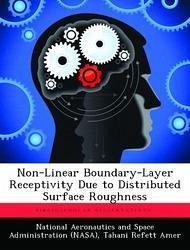The process by which a laminar boundary layer internalizes the external disturbances in the form of instability waves is known as boundary-layer receptivity. The objective of the present research was to determine the effect of acoustic excitation on boundary-layer receptivity for a flat plate with distributed variable-amplitude surface roughness through measurements with a hot-wire probe. Tollmien-Schlichting mode shapes due to surface roughness receptivity have also been determined, analyzed, and shown to be in agreement with theory and other experimental work. It has been shown that there is a linear relationship between the surface roughness and receptivity for certain roughness configurations with constant roughness wavelength. In addition, strong non-linear receptivity effects exist for certain surface roughness configurations over a band where the surface roughness and T-S wavelength are matched. The results from the present experiment follow the trends predicted by theory and other experimental work for linear receptivity. In addition, the results show the existence of non-linear receptivity effects for certain combinations of surface roughness elements.
Bitte wählen Sie Ihr Anliegen aus.
Rechnungen
Retourenschein anfordern
Bestellstatus
Storno









